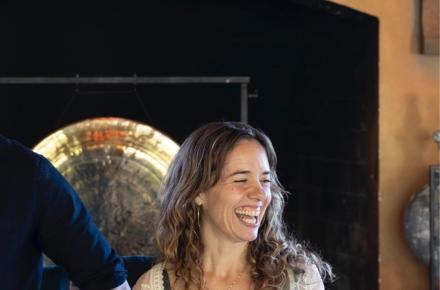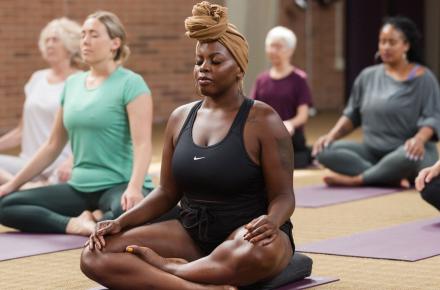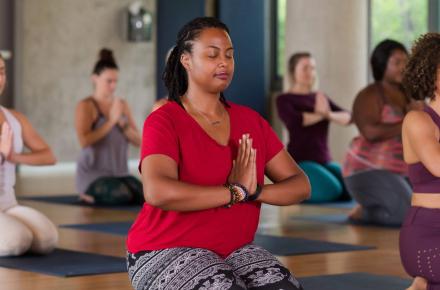Mindful Minute Meditations: A Little + Often = A Lot

July 27, 2020
by Tracy Foster
For many of us, the word meditation brings up all kinds of mental obstacles. “I can’t get comfortable. I just fall asleep. My mind is all over the place. Who has the time? There are so many distractions!” Yes, there will always be obstacles, the endless to-do list, all the shouldas and wouldas.
Yet the reality is that in as little as one minute of meditation you can begin to regulate your nervous system, shifting from the tension of stress mode to a more grounded, balanced state of being. Little meditative pauses, in doses of 60 seconds or more, sprinkled throughout the day, can add up to feeling calmer, more centered, and more connected.
With mindfulness meditation, you simply pay attention, on purpose, to the present moment, without judgment (in the words of Jon Kabat-Zinn). Another way to think about mindfulness is that you choose to pause and show up for yourself, in the here and now, without reaction, analysis, or criticism. You meet yourself with kindness and acceptance.
Why is this important, you may ask? Because you deserve your full attention and care. In this “A Little + Often = A Lot!” experiment, you will pause mindfully for just 60 seconds, and let go of any need to engage with doing; for one minute, you allow yourself to ease into being, one breath at a time.
Here is a menu of five Mindful Minute Meditations to practice anywhere, anytime, at home, at work, in the car, on a stroll, eyes open or closed. As you choose to pause and settle within yourself to meditate, your mind will undoubtedly become distracted or get lost in an inner story about the past or future. No worries; no beating yourself up. Simply notice that you’ve left the present moment and invite yourself back.
This isn’t just being kind to yourself. This is actually your meditation practice: welcoming yourself home, again and again, to the gift of presence.
For each meditation below, begin with the Letting-Go Breath. To do this, take a full, deep breath in through the nose, and then open your mouth and exhale with an audible sigh. This is sometimes called a clearing breath: big breath in to fill, and long breath out to release into the here and now.
As you finish each meditation, release the point of focus and feel what you feel. Allow integration as you notice what you’re aware of and anything that may have shifted. Then take another final Letting-Go Breath and consider whether A Little plus Often begins to equal A Lot.
Meditation on the Breath
Here, the breath becomes the anchor or touchstone for you to attach your attention to. As you notice you’ve spun off into thinking or judging, you kindly invite yourself back to the breath.
- Sit tall or stand, with head resting comfortably atop long spine and feet planted on floor; hands rest on lap or, if standing, at your side or on back of chair. Eyes may close or remain open with a soft focus towards the earth.
- Start with your Letting-Go Breath. As you breathe simply and naturally, welcome your mind and attention to your body breathing. No need to change or fix anything. Simply feel the breath breathe you. Notice where you feel the breath—at the tip of the nose, flowing down the throat, in the chest or low belly. Breathe and feel.
As Thich Nhat Hanh says, “Conscious breathing is practicing peace.” By bringing your awareness to the breath for as little as one minute, you are practicing being present with all that is. One breath at a time, you calm yourself and allow the body, mind, and breath to settle in together in a more peaceful way.
Meditation on Mantra
As an anchor for your meditation, adding a mantra (one or a few words) to say silently to yourself can be helpful. The mantra becomes the touchstone to come back to, again and again. Let your word(s) be positive, directive, and affirming. You might use these words coordinated with your breath: In–Out, or Here–Now. Thich Nhat Hanh suggests the mantra Breathing in I calm myself. Breathing out I smile.
Some people like to use counting as the focus—for example, practicing the Square Breath with numbers as the mantra. To try this, inhale on a count of four. Hold the breath for a count of four. Exhale on a count of four. Hold four counts and begin again. Smooth and steady.
Find what word(s) work best for you, start with your Letting-Go Breath, and then practice mantra meditation for one minute.
Body Scan
Body Scan is a journey of consciously inviting areas of tension in the body to relax and let go. This can be done seated, standing, or lying down.
- Begin to scan the body, noticing and observing what’s present in your physical structure. Where do you feel ease? Where might you release held tension?
- Take your Letting-Go Breath—breathe and sigh.
- For one minute, see if you can allow the muscles of your face to soften a bit and relax—forehead, bridge of the nose, jaw, roof of mouth, tongue.
- Release shoulders away from the ears and let shoulder blades melt down your back. See if you can soften the belly. Unclench the gluteal muscles (your seat) and unfurl your palms and fingers.
- Breathe and relax. As you soften, energy is able to flow more smoothly throughout the body and mind. You may find yourself feeling less tense and a little calmer and more grounded, clear, and balanced.
You can also practice Body Scan by letting your awareness travel sequentially up the body, from feet and toes up to the head. As you come upon areas of held tension or soreness, see if you can visualize sending the warmth of your presence and breath to those places, allowing them to soften and receive your caring attention.
Remember, as you scan the body, that there is no need to judge any tensions you become aware of. Simply observe without reacting. For one minute, meet yourself just as you are, with kindness.
Sit Spot Meditation
In sit spot meditation, you find a place, preferably outside or near a window with a view of nature; perhaps this is a place where you can come back, again and again.
- Sit and pause, allowing your body to land and settle. Soften your gaze or close eyes and take several full, easy breaths in through the nose and out the mouth with a sigh. Allow your sit spot and Mother Nature to hold and support you.
- Open your eyes, breathe naturally, and let your senses and awareness expand to take in whatever you feel and observe. Allow yourself to be nourished and fascinated by all you see, hear, smell, touch. I think of this as “wandering into a state of wonder.”
- If you become distracted by thoughts of the past or future, no worries. Simply invite yourself back. Make room for all that is present, especially gratitude—for yourself for choosing to sit, pause, and pay attention to the here and now; and for nature.
In sit spot meditation practice, you may find a deepening connection to nature and self that makes you want to linger longer. Here’s permission to make this practice your own, knowing that a few minutes (or more) of sit spot, in the early morning, at lunchtime, and/or later in the day, is always available to you.
Metta Meditation
Metta, or Loving-kindness, Meditation is a mantra practice of sending well wishes to loved ones; to someone or a group that is struggling right now; to “neutral” people like your fellow commuters or a grocery store clerk; to someone you’re in conflict with; to all beings; and, of course, to yourself.
These silent words of compassion become the mantra that anchor you to the present moment. I think of this practice as a mindful and heartful meditation. Sharon Salzberg suggests practicing “guerilla compassion”—silently blessing random people on line at the drugstore or in the cars next to you in traffic, and as an offering to our snarky, impatient, stressed-out selves.
For your one-minute Metta Meditation, you can try repeating the traditional phrases below, or feel free to meditate on whatever well-wishing words seem right and authentic for you.
May all beings and myself be safe, healthy, happy, peaceful and free.
May I/you/all beings be safe and protected.
May I/you/all beings be healthy and well.
May I/you/all beings be peaceful in mind and heart, with ease in body and spirit.
May I/you/all beings be free from suffering.
Metta is a nourishing practice; one that I’m grateful to come back to again and again.
I hope one or more of these meditation practices resonate with you. Remember you can tap into these meditations anytime, anyplace, from the first light of dawn to that last late-night moment before sleep. Try them on. Be gentle and patient with yourself, appreciating that practice brings many rewards. If you find a meditation you love and you have the luxury of time, feel free to extend the length. If 60 seconds is all you have, know that A Little + Often = A Lot!
Tracy Foster, MA, RYT 1000, is a compassionate Kripalu Yoga and meditation teacher and Mindful Outdoor Guide.





















































